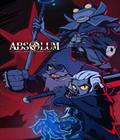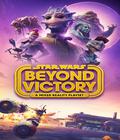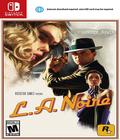Buy L.A. Noire
The interactive detective thriller L.A. Noire caused quite a bit of commotion when it was released in 2011. The prospect of lifelike facial animations and performing "real police work" to solve crimes was an exciting approach to the adventure genre, and the approach still stands out today. L.A. Noire recently received a subtly remastered re-release on current-gen consoles that still impresses with its partly fluid animations, good atmosphere, and tense storytelling while also showing its age and other shortcomings.
The PC, PS4 and Xbox One versions saw the biggest graphical improvements, but the Switch version only received smaller touch-ups with some more significant additions in the controls and feedback departments. Nevertheless, L.A. Noire is an unexpected release for the Switch, especially considering that Rockstar Games hasn't paid much attention to Nintendo in recent years. The release of L.A. Noire gives hope that Rockstar may deliver more titles for the system in the future.
L.A. Noire is set in 1947 Los Angeles and tells the detective crime story of Cole Phelps, a war veteran-turned-police officer who's going through the ranks of the LAPD. Starting out as a patrol officer, Phelps quickly shows the necessary wits to become a detective and soon works on major crimes in homicide, traffic and vice. The game is divided into individual cases that are set within an overarching story. While some are isolated incidents, others form a cohesive narrative or tie in to Phelps' storyline. The 26 cases — five of which are previous DLC cases — have us investigate crime scenes, question suspects and witnesses, and chase, gun and force our way through a gritty Los Angeles of the late '40s. Between cases, we see snippets about Phelps during the war.
Going through the cases and story, we work with different partners and report to different people. L.A. Noire does not shy away from difficult topics, so it not only depicts gruesome murders, rape and violence, but it also tackles societal issues in post-war Los Angeles, which is torn between Hollywood glamour, damaged returning soldiers, increasing opiate distribution through organized crime, and a patriarchal society. If there is one reason to play L.A. Noire, it's the nuanced writing that re-creates the world.
The cases we tackle usually start at the police department with a briefing and a crime scene to check out. From there, all cases follow a similar structure. We investigate a location, question subjects and witnesses, gain access to new locations, and eventually chase down a suspect to make an arrest or bring them in for final questioning.
During the investigation segments, we freely navigate a confined space and can interact with objects and dead bodies to find clues. By default, the game has a hint system that provides audio cues and rumble feedback when we're near an object that's vital to the investigation. Once we pick up those objects, we have the option to rotate them to find more clues or interact further. Once all of the clues have been discovered, the background music fades out, signaling that it's time to follow up on newly discovered leads. These hand-holding features can be turned off if you wish to make the experience more immersive and less obvious.
Finding as many clues as possible is essential so you can present the evidence while interrogating suspects and witnesses. It is possible to advance the story without finding all of the clues, but that may hinder your progress during the interrogations, which are the main attraction of the title. The faces of all characters in the game, no matter how insignificant, are captured with a special MotionScan technology. Real actors were filmed from all angles to replicate their facial features, so it's possible for you to interrogate a suspect and react based on their behavior.
In the original 2011 release , you had the option of choosing between "truth," "doubt" and "lie" to react to statements to move the interrogation along or learn more about the case. When you chose "lie," you had to back up your claim with clues to pressure the subject into confessing or rephrasing their statements. The three options remain largely intact in the remaster, but they've been renamed, respectively, to "good cop," "bad cop" and "accuse." One of the major complaints about the interrogation system in the original release was the inaccuracy of the options. Phelps' reaction with "doubt" sometimes turned out to be aggressive and insulting, and that's been slightly rectified with the relabeling. The three predetermined options may make it simple to choose from, but it would be helpful to get an idea of Phelps' reaction beforehand.
The MotionScan technology holds up reasonably well. The facial animations and impressions are still beautiful and benefit from great performances by the actors. There is an occasional blurriness around the mouth area. The actors aren't all on par, so some actors ridiculously overstate their facial expressions to make it unintentionally comedic or their expressions are too difficult to distinguish from a resting face. As the core of the game, this technology and the associated gameplay mechanics work well enough to keep you engrossed if you're a fan of well-written stories and acting. It's still one of the better story-driven games of the last decade and nails down the tiniest story details.
As for the cases, there are things to like and dislike. We can mess up cases by not discovering all clues or misreading facial expressions, but in the end, the only impact is different case ratings of one to five stars. The story would've been perfect if it allowed for more branching within the cases or the overall storyline. There are minor differences within cases if we don't work well, so we may not get to investigate a certain person or place, but it doesn't make too much of a difference, which is slightly discouraging.
It was a minor annoyance when it was released, but it's a bigger issue today. The acting and writing may be impressive, but the overall case structure quickly becomes repetitive as we investigate, interrogate, and chase down suspects. The game has significant pacing issues throughout the game. The last desk, arson, can be an underwhelming drag when compared to the superb homicide and vice cases that came before it.
L.A. Noire features and an incredibly detailed replica of Los Angeles in the '40s, which helps the immersion if you don't look too closely, and thankfully, the game seldom forces you into the open areas. All driving can be done by your partner to create an effective fast-travel system. There are also 40 street crimes to find. It wouldn't be exactly bad if the action set pieces were enjoyable, but unfortunately, the driving, running and shooting are the most unrefined aspects of the game. It feels clunky and repetitive no matter how often you try it. Players can also locate sightseeing spots and collectibles like film reels, newspapers, and up to 95 original cars from the era. If you're inclined to find them all, it'll keep you busy for a while, but there is very little incentive to do so.
Apart from facial animations, L.A. Noire didn't turn too many heads, even back then. While environments can look incredibly beautiful, there are just as many situations when the game pulls you out of the experience. Character movements appear stiff, which is even more evident when compared to the smoothness of the facial features. Running gameplay can be frustrating when Phelps has to trigger special animations to jump over or climb on obstacles. Driving feels very heavy, which is fine unless you get stuck in the environment. For example, I'm able to blast through park benches and newspaper stands but am brought to standstill by a wooden fence. These are small complaints, but they start to add up quickly.
L.A. Noire didn't run too well, even when it released. The game was optimized for the PS3 hardware and struggled to run on other systems, so it's great to find that L.A. Noire runs at mostly 30 fps in 1080p/720p in docked/handheld mode on the Switch. The frame rate occasionally drops, especially in docked mode when transitioning from closed buildings to the open world, and it shows noticeable slowdowns in these instances, but it's not as severe as witnessed in the Doom port for the Switch.
The Switch version overall is closer to the original PS3 game than to the even further improved PS4 and Xbox One versions. It seems to be sharper in its presentation, with some improved assets but an inferior draw distance. When driving with a fast vehicle, objects and textures pop in rather close, and reflections and far-away NPCs are animated with a noticeable drop to 15 fps. Shadows look great overall, especially in closed buildings, but they sometimes exhibit blocky artifacts, especially when you're inspecting an object. These issues appear both in docked and handheld mode, although the game looks way better on the small screen when played on the go.
Apart from graphical improvements, L.A. Noire on the Switch adds some platform-specific controls. The obligatory motion controls let us control the camera with the right Joy-Con instead of using the right stick, and we can interactively rotate objects to find clues. This works reasonably well, even though motion controls rarely feel integrated. If you're playing in handheld mode, you can use the touch-screen to control the game. While it technically works to complete the game that way, it didn't come together well for me. It feels inaccurate and occasionally misinterprets input. On top of that, L.A. Noire uses HD Rumble, which is hit-and-miss. While you're driving, hitting objects make the controller rumble on the side where you hit something, but braking and drifting do not trigger any feedback. During investigations and interrogations, HD Rumble is used to signal undetected clues and correct answers, but I cannot fathom why rumble feedback is used in the on-foot chase sequences. Climbing a ladder or pipe makes the controller rumble violently according to the footsteps taken. This is neither immersive nor well executed and detracts from the overall experience.
All in all, L.A. Noire is still an enjoyable story-driven adventure game with an incredible atmosphere. The issues that it had in 2011 are still present, but they're more noticeable today, so it's not as enjoyable as it was back then. It may make more sense for people who skipped it in 2011 to enjoy it in small doses while they're on the go. It is unfortunate that the Switch version is priced higher than the other versions. Players who have access to another platform and aren't interested in a portable gaming experience may be better served by the PC, PS4 or Xbox One version.
Score: 7.2/10
More articles about L.A. Noire











 L.A. Noire is an interactive detective story set in the classic noir period of the late 1940's. L.A. Noire blends action, detection and complex storytelling and draws players into an open-ended challenge to solve a series of gruesome murders.
L.A. Noire is an interactive detective story set in the classic noir period of the late 1940's. L.A. Noire blends action, detection and complex storytelling and draws players into an open-ended challenge to solve a series of gruesome murders.















































